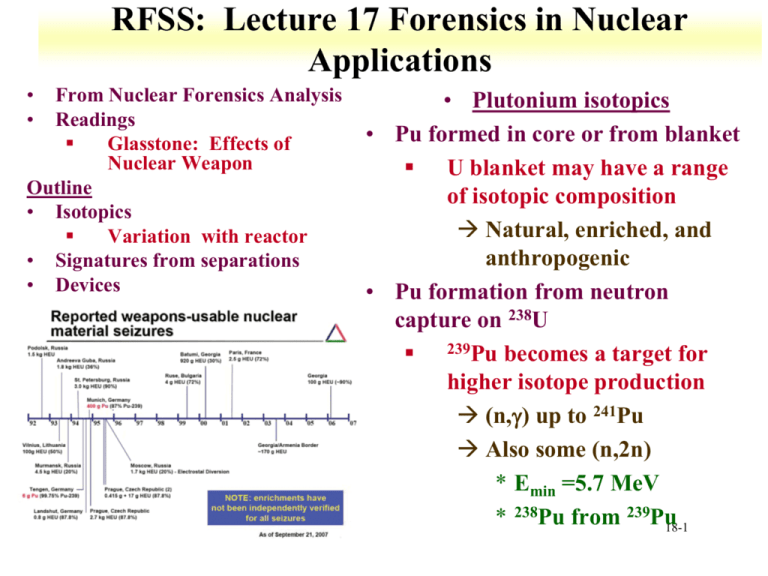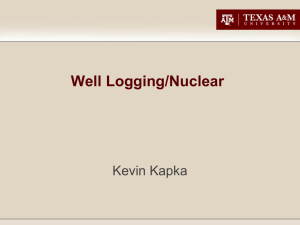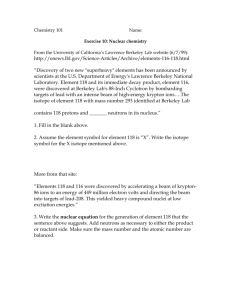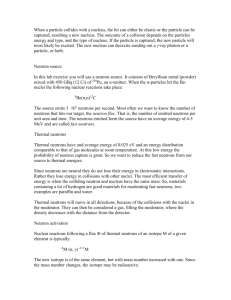PowerPoint
advertisement

RFSS: Lecture 17 Forensics in Nuclear Applications • • From Nuclear Forensics Analysis Readings Glasstone: Effects of Nuclear Weapon Outline • Isotopics Variation with reactor • Signatures from separations • Devices • Plutonium isotopics • Pu formed in core or from blanket U blanket may have a range of isotopic composition Natural, enriched, and anthropogenic • Pu formation from neutron capture on 238U 239Pu becomes a target for higher isotope production (n,g) up to 241Pu Also some (n,2n) * Emin =5.7 MeV * 238Pu from 239Pu 18-1 Plutonium isotopics • 238Pu can also be produced through successive neutron capture on 235U 235U(n,g)236U 236U(n,g)237U 237U beta decay to 237Np 237Np(n,g)238Np 238Np beta decay to 238Pu • Mixture of Pu isotopics from fuel or blanket can act as a signature 239Pu dominates at low burnups 18-2 Device Pu has 6 % 240Pu Plutonium isotopics: Neutron Fluence • • Pu isotopics influence by neutron fluence and energy Neutron energy effected by • reactor operating temperature Moderator Fuel size influences distance between neutron generation and moderator • Fuel composition can influence neutron spectrum • 240Pu Depletion of neutron in 235U resonance region due to higher interactions production Capture on 239Np produces 240Np, which decays into 240Pu Competition between capture and decay 18-3 Plutonium Isotopics • Evaluate ratios with 240Pu Mass 240:239 (MS) Activity 238/(239+240) (alpha spectroscopy) • Varied reactor types, 37.5 MW/ton • Large Pu isotopic variation • Obvious variation for blanket and CANDU 18-4 Plutonium Isotopics: Irradiation time • Comparison to 239Pu concentration Can provide time since discharge 241Pu is time sensitive • Change in measure and expect ratio can be used to determine time since discharge 18-5 Plutonium Isotopics • Use for evaluating reactor power Mass 242:239 ratio Activity 238/(239 +240) 18-6 Transplutonium Isotopics • Am (242m, 243) and Cm (242, 244) sensitive to reactor power Due to relative decay of 241Pu and formation of 241Am More 241Am is available for reactions from longer times with low flux * Weapons grade Pu from 10 day to 2 year irradiation • From neutron reaction and beta decay of heavier Pu • 243Pu beta decay to 243Am Capture and decay to 244Cm • Neutron capture on 241Am 242Am states Ground state decay to 242Cm • Strong flux dependence on ratios 18-7 6% 240Pu • 244Cm 241Pu • 242Cm and 243Am arise from multiple neutron capture on (t1/2=163 d) can determine time since discharge 18-8 Change from expected value compared to other ratios Reprocessing • 510 gU/g Pu for used fuel • Majority of U remains, enrichment level to 0.62% Depends upon the level of burnup • Reprocessing limitations Remote handling Criticality issues Limit impurities • Range of reprocessing techniques Precipitation Molten salt Ion exchange Fluoride volatility Solvent extraction 18-9 Reprocessing • • BUTEX Dibutyl carbitol solvent Relatively poor separation from Ru * 1E3 rather than 1E6 1 g Pu has 1E7 dpm 106Ru HEXONE Methylisobutylketo ne solvent Decontamination factors 1E4 Ru 1E5 for Zr, Nb, and Ce * 1 g Pu has 1000 dpm 93Zr • PUREX Zr, Tc, and Ru observed Ln, Np, and Th non-negligible Nd is a key isotope, nature levels in reprocessing materials Natural and reactor Nd ratios are plant signatures 18-10 35 • Isotopes in Pu from incomplete separation and decay Small masses, high activity 18-11 • • • Organic analysis Radiation effects Polymerization TBP degradation * Di, mono, and phosphoric acid N-butonal and nitrobutane Changes extraction behavior, limits extraction efficiency Formation of carboxylic acid, esters, ketones, nitroorganic compounds Signatures from processing Range of sample states, including gas GC-MS methods Reprocessing 18-12 Devices • General device overview • Single stage Gun type Implosion • Two stage • General signatures • • • Designed to have highest possible k (neutron multiplication factor) Greatest increase of neutrons and fission from one generation to the next Cooling from explosion k goes to zero Need to complete reaction in short time Designs maximized neutron and fissile material reaction Generation time Average time between neutron release and capture Neutron energy 1 MeV 10 n sec per generation * Shake 50 to 60 shakes to produce 1 kt of fission yield About 0.5 microseconds * Energy generation exponential * Most energy from last few generations 30 nsec extra increases yield by order of magnitude 18-13 Device general information • Fast neutron reflection important for device Better use of neutrons, lower critical mass • Reflector material high density Also slows down material expansion (tamper) • Critical mass Shape Composition Density Reflection • Minimization of non-fissile isotopes 18-14 Device general information • Fission spectrum neutrons drive the n,f reaction Not thermalized • Cross sections for fast neutrons orders of magnitude lower than thermal reactions n, gamma reaction for non-fissile isotopes also lower • Limiting non-fissile isotopes results in material signatures Less than 7 % 240Pu More than 20 % 235U Low 232U in 233U (10 ppm) 18-15 Device general information • Low Z material in Pu not desired React with neutrons Lowers density Moderates neutrons Used as signature * Pu device isotopes in non-metal form indicates storage or starting material • Alloys Ga in Pu Nb in U Fabrication ease and corrosion resistance 18-16 Post-detonation analysis • Debris provides information on Function Source • Efficiency of yield from fuel and fission products High efficiency indicates sophisticated device Also with multiple fissile material and (n,2n) reactions • Indication of initial isotopic compositions Neutron energy influences fission product distribution Also varies with nuclear fuel • Neutron reactions with device material 18-17 Overview • General device overview k for devices Timing and neutron interactions Neutron energy Shape and configurations • Single stage Gun type Implosion Boosting • Two stage Tritium generation • General signatures 18-18 Questions • • • • • • • • • • • What are the different types of conditions used for separation of U from ore What is the physical basis for enriching U by gas and laser methods? What chemistry is exploited for solution based U enrichment Describe signatures from the enrichment process for different methods. Describe 4 different types of reactors What signatures are available from Pu isotopic ratios Transplution isotopic ratios Sm isotopic ratios Describe the basic chemistry for the production of Th, U, and Pu metal Why is Pu alloyed with Ga? How does neutron multiplicity relate to devices Describe a gun type device How can tritium be formed in a device What is the role of high energy neutrons in a device 18-19






